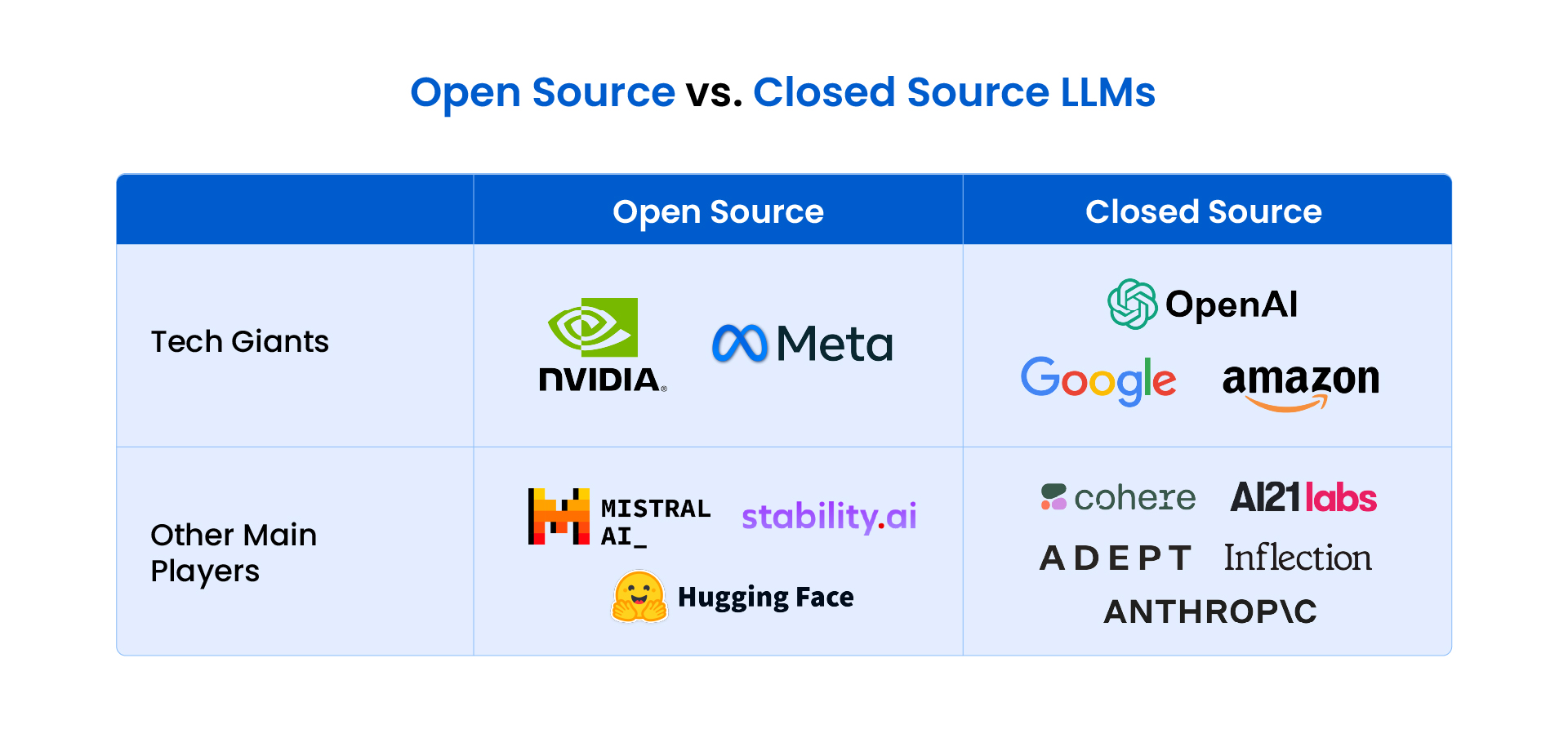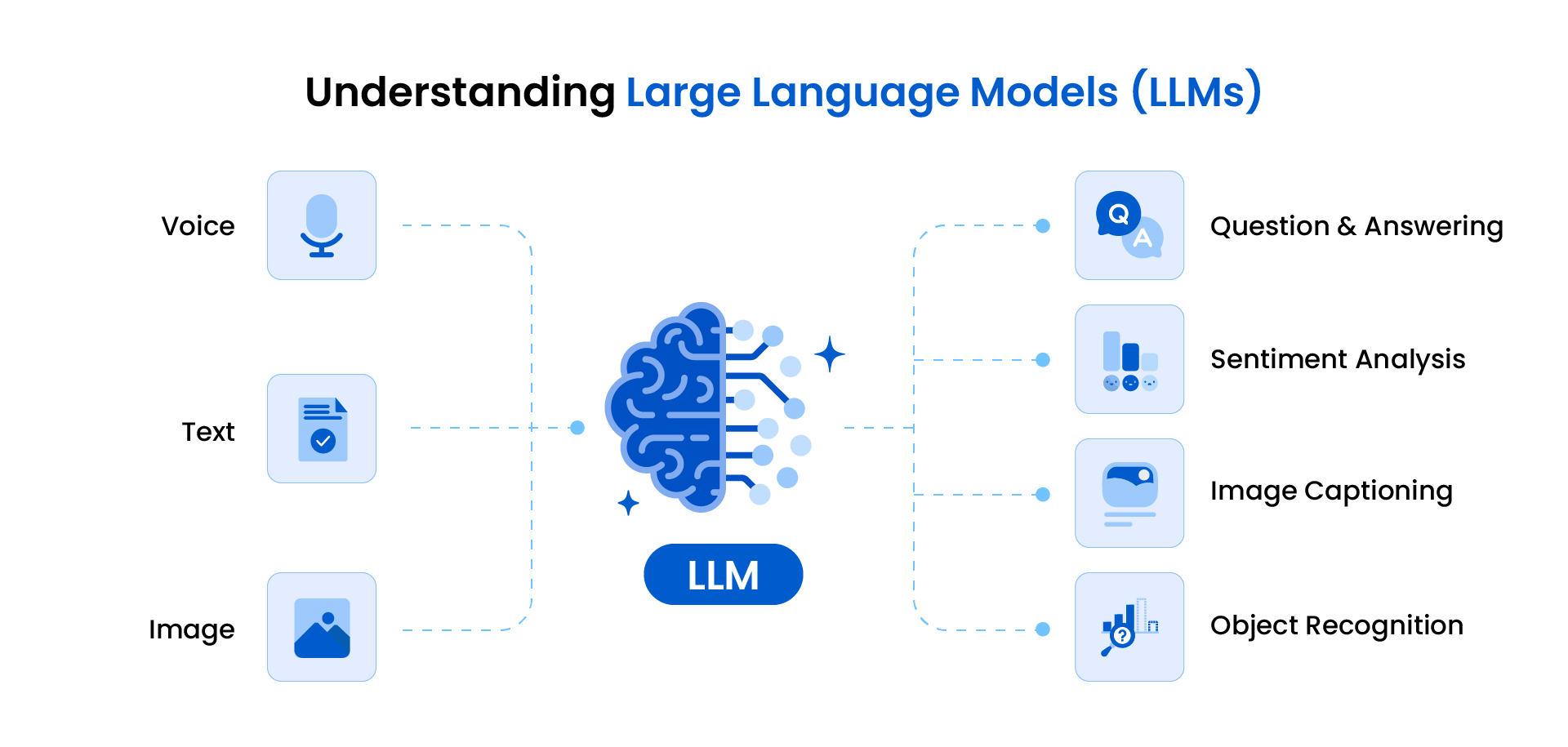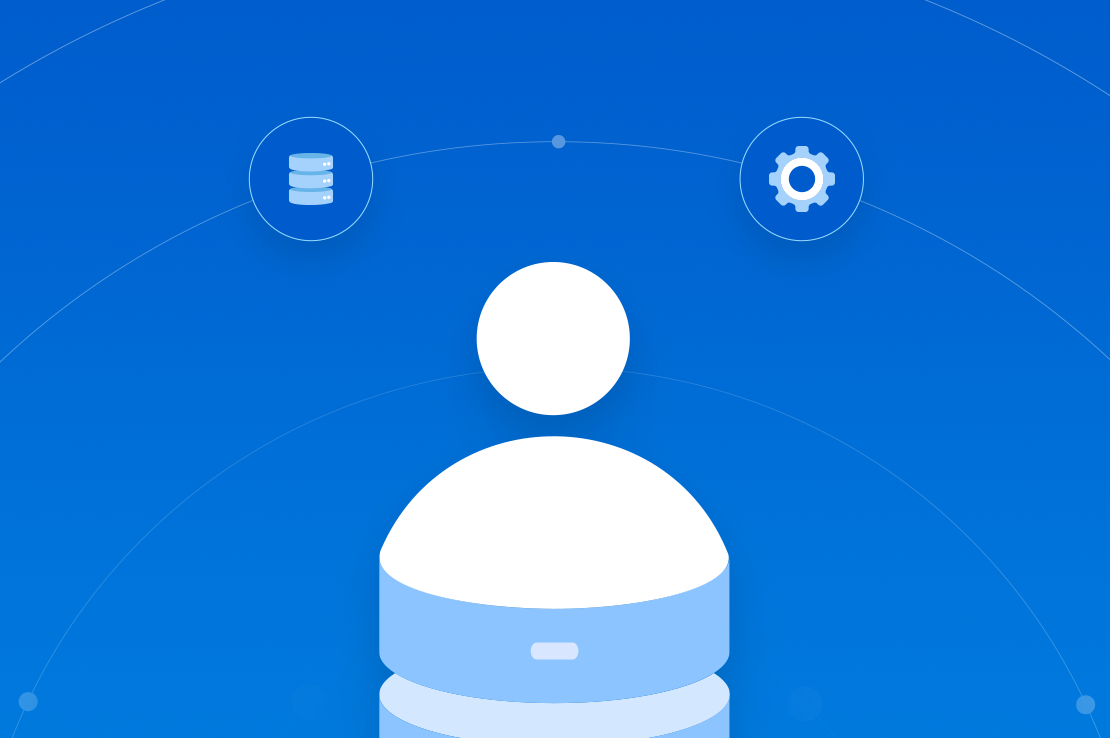
Open Source vs. Closed Source LLMs: Which is Better for Enterprises?
The market for artificial intelligence (AI) stood at $184 billion in 2024 and is expected to more than quadruple in the next six years. While these expectations are astonishing, AI experts think they’re conservative, to say the least, and the actual market value would be considerably bigger.
Large language models (LLMs) like GPT 3 have ushered in the age of AI. They’re finding applications as varied as complex scientific research and writing lyrics for rap battles. In other words, almost every person is using these LLMs for something.
But what about enterprises? McKinsey reports that 65% of enterprises are regularly using LLMs, a number that doubled in less than ten months. In fact, enterprise-grade firms are likelier to adopt AI technologies like LLMs.
For enterprises looking to integrate LLMs into their workflow, the very first conundrum is choosing between open source vs closed source LLMs. This blog settles that debate today.

Understanding LLMs and Its Types
What is an LLM?
LLM, short for Large Language Model, is how millions of users (123.5 million to be exact) talk to ChatGPT every day. In the simplest of terms, an LLM is a large model designed using machine learning (ML) techniques to perform language tasks such as writing text, reasoning, and comprehension, much like humans do. LLMs are being widely used for a variety of natural language processing tasks, with the output being in the form of text, images, video, audio, or computer code.
It’s true that recently LLMs have captured the collective imagination of the tech sector. However, the capabilities that large language models have today took years of innovation and iteration.
Rule-based systems are the predecessors of modern LLMs. These systems rely on manually established rules to process natural language input. Fast-forward to today and LLMs can be trained to recognize patterns, generate natural language output with nuance and complexity, and process sentiment analysis.

Types of LLMs
Large language models (LLMs) can be classified in several different ways, such as by use case, training data, or availability. When classified by availability, LLMs can be open-source or proprietary/closed. This choice between open-source and closed LLMs is important because it decides the direction, scope, budget, and timeline of the company’s LLM initiative.
Open-Source LLMs
Open-source LLMs are freely available models that anyone can use, customize, and distribute. Typically, a community of researchers and developers exists around these LLMs for their development and support. For instance, anyone can inspect the code, identify issues, suggest improvements, and adapt the model for specific purposes, which ensures community-driven progress.
Some popular examples of open-source LLMs include Llama 3, GPT 2, and BERT. Let’s look at some of the biggest advantages and challenges of using open-source LLMs for enterprises:
The Good,
The following are the biggest advantages of open-source LLMs for enterprises:
- Transparency: Open-source LLMs are easier for enterprises to trust because their training dataset and code are publicly accessible. This level of transparency also helps in identifying and mitigating any potential bias.
- Customization: Since their code and training data are publicly available, these models can easily be tailored for specific use cases.
- Cost efficiency: Open-source models are free to use without licensing fees so their overall development and deployment costs are lower than those of closed-source models.
The Bad,
Despite its many upsides, enterprises also face several potential challenges with open-source models, such as:
- Resource-Intensive: Open-source models are typically built on the contributions of smaller teams and volunteers. Enterprises looking to build upon open-source LLMs will need to invest significantly in training and customization.
- Security & Compliance: Open-source development of LLMs can also present potential vulnerabilities if proper security and compliance standards haven’t been followed.
…And The Verdict
While using open-source LLMs can prove more resource-intensive, this can be offset by the approach’s overall cost efficiency. Plus, unrestricted access to the code and data, as well as the ability to customize, will make it worthwhile for enterprises.
Closed-Source LLMs
Closed-source LLMs are proprietary models developed and maintained in a private environment. Access to the model’s training data and code is restricted, which means the model can only be tweaked by the organization or, in some cases, those willing to pay for the access.
OpenAI’s GPT-3 and 4 are popular examples of closed models. Let’s look at the benefits and downsides of using closed-source models for enterprises:
The Good,
- Competitive Edge: Closed-source LLMs typically offer enterprises access to unique, proprietary technologies that can also be fine-tuned for specific industry needs.
- Dedicated Support: Unlike open-source LLMs, this approach comes with dedicated support from vendors, which ensures stability, compliance, and security. This can prove to be crucial for enterprise-grade use cases.
The Bad,
- Limited Control and Customization: This is perhaps the biggest hurdle of leveraging proprietary models, i.e., limited to no control and customization. Enterprises can’t tailor the model’s code or training data and are limited to what the vendor provides.
- Higher Costs: Compared to the open-source models, the proprietary route requires dealing with high licensing fees. Plus, potential vendor lock-in can further increase the overall cost.
…And The Verdict
While closed-source LLMs offer greater ease of use and dedicated support, the lack of control and customization means this approach is only a good fit for enterprises that can find closed LLMs that perfectly fit their use cases.
Key Considerations for Enterprises
For enterprises choosing between open-source and closed-source large language models for their AI initiatives, it’s important to consider the following factors:
- Use Case Requirements: Enterprises should ensure their choice of LLM aligns with their use case and specific business needs and objectives.
- Budget Constraints: The total cost of ownership (TCO) should be evaluated, which should include licensing, implementation, and maintenance.
- Security and Compliance: For highly regulated industries such as healthcare and finance, it’s crucial to choose a model that meets industry standards and regulatory requirements.
- Scalability and Support: Enterprises should assess the ability to scale and the level of support required for ongoing operations.
- Degree of Customization and Control: Enterprises should also ensure that their choice of LLM aligns with the required degree of customization and control.
Welcome AI Into Your Enterprise with Astera
Leverage LLMs to make the most of your data and workflows. Make the most of Astera's unique expertise working on the intersection of data integration and GenAI.
Discuss your AI-powered data strategy with usOpen-Source LLM is the New Enterprise Darling
Proprietary models like OpenAI’s GPT-4 led the early adoption wave. However, open-source models have since been closing the gap in terms of quality and have seen increased adoption in the enterprise market.
Take Meta’s publicly available large language models, for example. In 2024, they were downloaded 400 million times, at a rate 10 times higher than the previous year. In fact, Llama usage doubled between May and July 2024.
This is largely driven by an increased understanding of AI and enterprises looking for greater control, customization, and cost efficiency. Plus, enterprises are looking to avoid vendor lock-in as OpenAI’s domination is being challenged from multiple directions and major breakthroughs can come from anywhere in the AI industry.
In short, closed-source models are still leading overall and with the individual developers and startups. However, in the enterprise landscape, the tide is turning as major players like Salesforce and Slack are rolling out the red carpet for enterprises wanting to leverage open models. For instance, Salesforce recently launched Agentforce, which lets companies connect any LLM within Salesforce applications.
How Astera Is Leveraging Open-Source LLMs
Astera’s LLM Generate empowers enterprises to combine the LLM of their choice with their data pipelines to create AI-powered solutions.
With LLM Generate, users can retrieve an output from an LLM model based on the input prompt. Users can select from a choice of LLM providers, including OpenAI, Llama, etc., and can also use custom LLM models.
Get in touch today to discuss your AI needs with us.
 Astera AI Agent Builder - First Look Coming Soon!
Astera AI Agent Builder - First Look Coming Soon!


